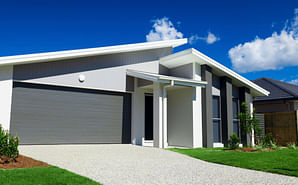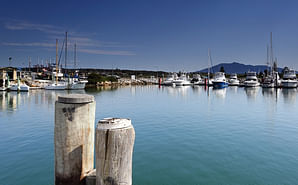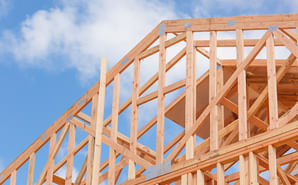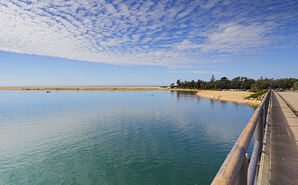Water and Sewerage charges
Service charges for water and sewerage, including access charges.
On this page
- Water services - supply charges
- Sewerage services - supply charges
- Liquid trade waste - supply charges
- High usage water and sewer - supply charges
- On-site sewer management (OSM)
Water services - supply charges
Our water charging structure consists of two components, a water access charge and a water usage charge.
The estimated income for 2025-26 from the two charge components is shown below.
| Income source | 2025-26 Estimate |
|---|---|
| Water access charge | $5,406,906 |
| Water usage charge | $10,543,420 |
| Total | $15,950,32 |
Water access charges (Sec 501)
The water access charge (ACw) is charged annually to all residential and non-residential properties. It is determined by the water service connection size, according to the formula:
AC = AC20 x D2/400
- AC = Water access charge ($)
- AC20 = Water access base charge ($)
- D = Water services connection size (mm)
The water access base charge (AC20) is defined by the size of a standard residential 20mm water service connection.
The water access base charge (AC20) for 2025-26 is shown below.
| Charge | 2025-26 $/connection |
|---|---|
| Water accs base charge (AC20) | $315 |
Variations to the charging formula for ACw apply for:
- strata title properties - units/flats/apartments/ townhouses/villas
- multiple residence properties, where individual separate dwellings are situated on a single parcel of land (including but not limited to non-strata flats/units/villas, secondary dwellings and dual occupancies)
- retirement villages and multi-residence affordable housing
- Non- residential non-rateable community organisations
- mixed use developments
- water connections for fire services
These are considered separately below.
Strata title properties
Strata title properties are charged the water access base charge for each rateable parcel of land created under a strata title subdivision, regardless of water service connection size, or the number of water service connections, according to the formula:
ACw = AC20 – applied to each rateable parcel of land created under a strata title subdivision.
Multiple residence properties
Multiple residence properties, where individual separate dwellings are situated on a single parcel of land (including but not limited to non-strata flats/units/villas, secondary dwellings and dual occupancies) are charged a water access charge based on the number of dwellings, regardless of water service connection size, or the number of water service connections, according to the formula:
ACw = AC20 x ND
- ACw = water access charge ($) – multiple residence properties
- AC20 = water access base charge ($)
- ND = no. residential dwellings
Retirement villages and multi-residence affordable housing properties
Residential retirement villages and multi-residence affordable housing properties are charged a water access charge for each water service connection with a discount factor applied, according to the formula:
ACw = AC20 x D2/400 x DF
- ACw = water access charge ($) – retirement villages and multi-residence affordable housing
- AC20 = water access base charge ($)
- D = water service connection size (mm)
- DF = discount factor
The discount factor (DF) for 2025-26 is shown below.
| Charge | 2025-26 |
|---|---|
| Discount factor | 0.85 |
Eligibility for the residential categorisation and discount factor is determined on an application basis:
- retirement village operators must provide proof of notification to the Registrar General that the land, or part of land, is used as a retirement village
- Multi-residence affordable housing operators must apply and obtain approval that the land, or part of land, is used as residential affordable housing (State Environmental Planning Policy Housing 2021 - 13 Affordable housing—the Act, s 1.4(1)
Non-residential non-rateable community organisations
Connected properties for non-residential non-rateable community organisations are charged the water access base charge with a discount factor applied, according to the formula:
ACw = AC20 x DF
- ACw = water access charge ($) – non-residential non-rateable community organisations
- AC20 = water access base charge ($)
- DF = discount factor
The discount factor (DF) for 2025-26 is shown below.
| Charge | 2025-26 |
|---|---|
| Discount factor | 0.85 |
Mixed-use developments
Connected properties rated as mixed-use for commercial and residential use are charged a water access charge based on the water service connection size and a water access base charge for each residential dwelling at the same site, according to the formula:
ACw = (AC20 x D2/400) + (AC20 x ND)
- AC = water access charge ($) – mixed use developments
- AC20 = water access base charge ($)
- D = water supply service connection size (mm)
- ND = no. residential dwellings
Examples of such premises include a shop with a dwelling at the rear or upstairs, a commercial premise incorporating shop-top housing, or a caretaker’s unit in an industrial area.
Fire services
No water access charge applies to approved dedicated fire service connections. This exemption is forfeited if metered water usage occurs outside of emergency use. An access charge based on increments of the water access base charge will then apply.
Unconnected properties
Unconnected properties within 225 meters of a water main are charged an unconnected water access charge.
The unconnected water access charge for 2025-26 is shown below.
| Charge | 2025-26 $/connection |
|---|---|
| Unconnected water access charge | $315 |
Water usage charge (Sec 502)
The water usage charge is a variable charge based on the volume of water used and metered through a property water meter in kilolitres (kL). It is charged four times a year, according to the formula:
UCw = Q x UC
- UCw = water usage charge ($)
- Q = metered water use (kL)
- UC = water usage charge rate ($/kL)
The water usage charge rate (UC) for 2025-26 is shown below.
| Charge | 2025-26 S/kL |
|---|---|
| Water usage charge rate (UC) | $3.95 |
Home dialysis and home care medical patients
Connected properties with home dialysis and home care medical patients may obtain an allowance for water use. We require certification by a medical practitioner for this allowance to apply.
Sewerage services - supply charges
Our sewerage charging structure consists of a single-part residential sewer access charge and a two-part non-residential sewer access and usage charge.
The estimated income for 2025-26 from the two charge components is shown below.
| Income source | 2025-26 Estimate |
|---|---|
| Residentail sewer - access charge | $20,248,135 |
|
Non-residential sewer
|
$2,231,726 |
| Total | $24,728,329 |
Residential sewerage charges(Sec 501)
The residential sewer access charge (ACR) is charged annually to all connected residential properties. It is a fixed charge equal to the residential sewer access base charge, according to the formula:
ACR = ACRS
- ACR = residential sewer access charge ($)
- ACRS = residential sewer access base charge ($)
The residential sewer access base charge (ACRS) for 2025-26 is shown below.
| Charge | 2025-26 $/connection |
|---|---|
| Residential sewer access base charge (ACRS) | $1,589 |
Variations to the residential charging formula for ACR apply for:
- strata title properties - units/flats, apartments, townhouses
- multiple residence properties, where individual separate dwellings are situated on a single parcel of land (including but not limited to non-strata flats/units/villas, secondary dwellings and dual occupancies)
- residential retirement villages and multi-residence affordable housing properties
These are considered separately below.
Strata title properties
Strata title properties are charged the sewer access base charge for each rateable parcel of land created under a strata title subdivision, regardless of water service connection size, or the number of water service connections, according to the formula:
ACR = ACRS – applied to each rateable parcel of land created under a strata title subdivision
- ACR = residential sewer access charge ($)
- ACRS = residential sewer access base charge ($)
Multiple residence properties
Multiple residence properties, where individual separate dwellings are situated on a single parcel of land (including but not limited to non-strata flats/units/villas, secondary dwellings and dual occupancies) are charged the residential sewer access base charge for each separate dwelling, regardless of water service connection size or number of water service connections, according to the formula:
ACR = ACRS x ND
- ACR = residential sewer access charge – multiple residence properties ($)
- ACRS = residential sewer access base charge ($)
- ND = no. dwellings
Residential retirement villages and multi-residence affordable housing properties
Residential retirement villages and multi-residence affordable housing properties are charged a sewer access charge for each water service connection, with a discount factor applied, according to the formula:
ACR = ACRS x D2/400 x DF
- ACR = residential sewer access charge –residential retirement villages and multi-residence affordable housing
- ACRS = residential sewer access base charge ($)
- ND = no. dwellings
- DF = discount factor
The discount factor (DF) for 2025-26 is shown below.
| Charge | 2025-26 |
|---|---|
| Discount factor | 0.85 |
Eligibility for the residential categorisation and discount factor is determined on an application basis outlining:
- retirement village operators must provide proof of notification to the Registrar General that the land, or part of land, is used as a residential retirement village
- multi-residence affordable housing operators must apply and obtain approval that the land, or part of land, is used as residential affordable housing (State Environmental Planning Policy Housing 2021 - 13 Affordable housing—the Act, s 1.4(1)
Non-residential sewer access charge
The non-residential sewer access charge (ACNR) is charged annually to all connected non-residential properties. It is a charge based on the non-residential sewer access base charge, water supply service connection size and a sewer discharge factor, according to the formula:
ACNR = ACNRS x D2/400 x SDF – for each connected water service
- ACNR = non-residential sewer access charge ($)
- ACNRS = non-residential sewer access base charge ($)
- D = water supply service connection size (mm)
- SDF = sewer discharge factor
The non-residential sewer access base charge (ACNRS) for 2025-26 is shown below.
| Charge | 2025-26 $/connection |
|---|---|
| Non-residential sewer access base charge (ACNRS) | $1,589 |
The sewer discharge factor is a percentage of metered water use deemed to discharge to sewer. It applies to both non-residential access and usage. The percentage is based on guidance material for different property types provided to us by the NSW government.
Variations to the non-residential charging formula for ACNR apply for:
- non-rateable community organisations
- mixed use developments
These are considered separately below.
Non-residential non-rateable community organisations
Connected properties for non-residential non-rateable community organisations are charged the non-residential sewer access base charge (ACNRS) multiplied by a discount factor, regardless of water service connection size, or the number of water service connections, according to the formula:
ACNR = ACNRS x DF
- ACNR = non-residential sewer access charge – non-residential non- rateable community organisation
- ACNRS = non-residential sewer access base charge ($)
- DF = discount factor
The discount factor (DF) for 2025-26 is shown below.
| Charge | 2025-26 |
|---|---|
| Discount factor | 0.85 |
Mixed use developments
Connected properties rated as mixed-use for commercial and residential use are charged a non-residential sewer access charge and the residential sewer access base charge (ACRS) for each residential dwelling at the same site, according to the formula:
ACNR = (ACNRS x D2/400 x SDF) + (ACRS x ND)
- ACNR = non-residential sewer access charge – mixed use developments ($)
- ACNRS = non-residential sewer access base charge ($)
- D = water supply service connection size (mm)
- SDF = sewer discharge factor
- ACRS = residential sewer access base charge ($)
- ND = no. dwellings
Examples of such premises include a shop with a dwelling at the rear or upstairs, a commercial premise incorporating shop-top housing, or a caretaker’s unit in an industrial area.
Unconnected properties
Unconnected residential and non-residential properties within 75 meters of a sewer main are charged an unconnected sewer access charge.
The unconnected sewer access charge for 2025-26 is shown below.
| Charge | 2025-26 $/connection |
|---|---|
| Unconnected sewer access charge | $795 |
Non-residential sewer usage charge (Sec 502)
The non-residential sewer usage charge is a variable charge for non-residential properties. It is determined by the volume of metered water use in kilolitres (kL) multiplied by a sewer discharge factor and a charge rate. It is charged four times a year, according to the formula:
UCNR = Q x SDF x UC
- UCNR = non-residential sewer usage charge
- Q = metered water use (kL)
- SDF = sewer discharge factor
- UC = non-residential sewer usage charge rate ($/kL)
The non-residential sewer usage charge rate (UCNR) for 2025-26 is shown below.
| Charge | 2025-26 S/kL |
|---|---|
| Non-residential sewer usage chargeate (UC) | $5.70 |
Working out your total non-residential sewer bill
A non-residential sewer bill is determined according to the formula:
B = ACNR + UCNR
- B = non-residential sewer bill ($)
- ACNR = non-residential sewer access charge ($) – charged annually
- UCNR = non-residential sewer usage charge ($) – charged four times a year
Liquid trade waste - supply charges
Liquid trade waste (LTW) is all liquid waste other than sewage of a domestic nature discharged to the sewerage system from non-residential properties. LTW adds additional cost to transporting and treating sewage. To recover these costs and to remove cross-subsidies from residential customers, fees and charges are applied to LTW dischargers. LTW fees and charges are in addition to non-residential sewer charges and include general fees and charges, category-specific usage charges and non-compliance charges.
General fees and charges
LTW general fees and charges are included in our 2025-26 Fees and Charges document. They include:
- Application fees
- Inspection fees
- Non-compliance charges
Usage charges (Sec 502)
LTW dischargers are divided into four categories for usage charging purposes. The four categories and formulas used for LTW usage charges are outlined below.
Category 1: LTW dischargers requiring nil or minimum pre-treatment
No usage charge applies.
Category 2: LTW dischargers with prescribed pre-treatment
The LTW usage charge for category 2 dischargers is calculated according to the formula:
LTW2 = Q x LTWDF x UC2
- LTW2 = LTW usage charge for category 2 dischargers ($)
- Q = metered water use (kL)
- LTWDF = LTW discharge factor
- UC2 = LTW usage charge rate ($/kL)
The LTW discharge factor is a percentage of metered water use deemed to discharge to sewer as LTW. The percentage applied is based on guidance material for different discharger types provided to us by the NSW government.
The category 2 LTW usage charge rate (UC2) for 2025-26 is shown below.
| Charge | 2025-26 $/kL |
|---|---|
| LTW usage charge rate - category 2 (UC2) | $2.40 |
Category 2S: LTW dischargers that transport sewage waste to sewage treatment plants
This category includes transporters that tanker human waste to sewage treatment plants from septic tanks, portable toilets, pit toilets, on-site sewage management systems and ship-to-shore pump-out facilities.
LTW2s = Q2s x UC2s
- LTW2s = LTW usage charge for category 2S dischargers
- Q2s = LTW discharge volume (kL)
- UC2s = LTW usage charge rate ($/kL)
The category 2S LTW usage charge rate (UC2s) for 2025-26 is shown below.
| Charge | 2025-26 $/kL |
|---|---|
| LTW usage charge rate - category 2S (UC2s) | $20.00 |
Category 3: Large (<20 kL/d) and industrial LTW dischargers
The LTW usage charge for category 3 dischargers is calculated according to the formula:
LTW3 = EMC
- LTW3 = LTW usage charge for category 3 dischargers
- EMC = excess mass charges ($)
Excess mass charges (EMC) are for large and industrial LTW dischargers that discharge LTW above ‘deemed concentrations’ in domestic sewage. EMCs are based on NSW Government advice in the Liquid Trade Waste Management Guidelines 2021. The unit charging rates ($/kg) for each substance are obtained from guidance material provided to Council by the NSW Government.
Non-compliance charges
Non-compliance charges are included in our 2025-26 Fees and Charges document. Non-compliance charges are for dischargers that have not installed or maintained pre-treatment equipment, or complied with a notice to install or maintain pre-treatment equipment.
High usage ater and sewer - supply charges
High usage charges are additional charges levied on non-residential customers who have used more capacity in our water and sewerage networks than previously paid for. Capacity is expressed in terms of a ‘credit volume’ for water used and sewage discharged in kL/y.
For existing non-residential connections, a credit volume is determined by either previous section 64 developer contributions paid, or a 10-year 80th percentile water use from 2010-2019, according to the formulas:
CVw = ET x 205 kL/y
CVs = ET x 190 kL/y
- CVw = credit volume water (kL/y)
- CVs = credit volume sewer (kL/y)
- ET = developer contributions previously paid expressed as equivalent tenement
CVw = u + Zs
CVs = (u + Zs) x SDF
- CVw = credit volume water (kL/y)
- CVs = credit volume sewer (kL/y)
- u = average of annual water use 2010-2019 (outliers removed)
- Z = statistical z value of corresponding to the 80th percentile in a normal distribution (0.84)
- s = standard deviation
- SDF = sewer discharge factor
For new non-residential connections, a credit volume of 205 kL/y for water and 190 kL/y for sewer are allocated where developer contributions have been paid previously. Where contributions have not been paid, a minimum credit volume of 205 kL/y for water and 190 kL/y for sewer must be purchased at rates within our 2025-26 Fees and Charges document.
High usage charges apply for water used and sewage discharged beyond the credit volumes assigned to a non-residential property. High usage charges are charged annually following the final water meter read in a financial year, according to the formulas:
HUCNRW = Q x HUCW
HUCNRS = Q x SDF x HUCS
- HUCNRW = high usage charge non-residential water
- HUCNRS = high usage charge non-residential sewer
- Q = metered water use (kL)
- SDF = sewer discharge factor
- HUCW = high usage charge rate water ($/kL)
- HUCS = high usage charge rate sewer ($/kL)
The high usage charge rates for 2025-26 are shown below.
| Charge | 2025-26 $/kL |
|---|---|
| High usage charge rate water (HUCW) | $3.00 |
| High usage charge rate sewer (HUCS) | $4.54 |
The high usage charge rates are re-calculated annually. A net present value calculation is used where the developer charges for water and sewer are discounted over 30 years with a rate equal to the IPART Local Government Discount Rate (3.5% in December 2024).
Additional credit volumes can be purchased at any time at the section 64 developer contribution rate shown in our 2025-26 Fees and Charges document. No additional credit volumes will accrue through payment of the high usage charge.
On-site sewer management (OSM)
Council will charge a single annual amount on rates and charges notices which helps fund OSM program required to manage the risk that onsite sewage management systems pose to human health and the environment. Program services include routine inspections of systems based on risk classification, inspections of voluntary upgrades to systems, administration, and advice/education.
Separate fees will still apply for Section 68 Approval to Install/Alter Systems of Onsite Sewage Management, and inspections of new systems.
Estimated income for On-Site Sewer Management in 2025-26 is $326,468. (Sec 608 [2])
| Risk Category | Charge |
|---|---|
| OSM - Low risk (10 year cycle) | $47.00 |
| OSM - High risk (3 year cycle) | $83.00 |
| OSM - Critical risk 1 year cycle) | $185.00 |
Related information






